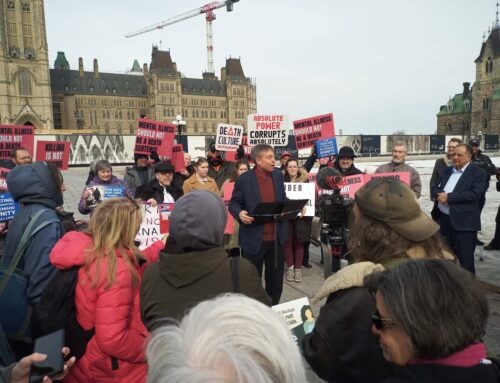Editor’s Note: The following is an interview with Diane Coleman, founder of the disability rights group Not Dead Yet, by Alex Schadenberg, executive director of the Euthanasia Prevention Coalition. Not Dead Yet is a co-sponsor of the upcoming International Symposium on Euthanasia and Assisted Suicide that is entitled: Current Issues – Future Directions. The International Symposium, Nov. 30–Dec. 1, is being organized by Euthanasia Prevention and will be held at the Four Points by Sheraton – Toronto Airport Hotel. Please go to the ad on page 8 in this issue of The Interim for more info.
Alex Schadenberg: How did Not Dead Yet get started? Was there a particular concern that led to it being launched?
Diane Coleman: Beginning in the mid-1980s, disability rights activists in the U.S.A. became concerned about a trend in legal cases that created and expended a so-called “right to die,” touting it as a progressive cause, but almost always focused on ending the life of a disabled person. Then, in the early 1990s, Jack Kevorkian gained great popularity and his body count was comprised of 70 per cent people with disabilities who were not terminally ill, despite media reports to the contrary. Finally, in early 1996, two federal appellate courts declared assisted suicide to be a constitutional right and Kevorkian was formally acquitted in the deaths of two disabled women. That was the perfect storm that led to the founding of a street action group to address these issues. On April 27, 1996, I was attending a national disability policy summit with 200 leading disability advocates and was then going to present invited testimony to a congressional subcommittee on behalf of myself and Dr. Carol Gill, opposing legalization of assisted suicide. When I arrived at the summit, the leader of ADAPT (see www.adapt.org/) told me, “I’ve got a name for your group.” A group that many advocates had felt was needed. He suggested “Not Dead Yet,” from Monty Python and the Holy Grail, so that day became the day the group was founded, the day we got our name. I wrote it on a piece of paper and distributed the subcommittee testimony during meeting breaks and got about 40 endorsements, including from Justin Dart, Jr., known as “father” of the ADA.
AS: Not Dead Yet is one of the most influential disability rights organizations in the United States. We have heard about Not Dead Yet protests; describe what led you and the group into activism?
DC: Several disability rights leaders had attempted to stop the euthanasia steamroller through more acceptable forms of policy work, including writing articles for a wide range of publications from newspapers to academic journals, presenting conference workshops, testifying in courts and legislatures, communicating through broadcast media and so on. But people with disabilities continued to be pushed to choose death or to have death chosen for them by others, so the community became convinced that the only way to raise our voices loud enough was to add rallies, protests and non-violent civil disobedience to our tactics. In the U.S., that meant starting a group like ADAPT. Many ADAPT activists are also part of Not Dead Yet and have participated in protests. Our first protest was June 21, 1996 in Kevorkian’s backyard and our most recent was at Kevorkian’s prison release press conference in early June in Michigan. We have been at the U.S. Supreme Court twice, at Princeton regarding the hiring of Peter Singer, at several bioethics conferences and at pro-assisted-suicide conferences (Hemlock Society, World Federation of Right to Die Societies) and in Florida regarding Terri Schiavo, among others.
AS: What other activities is Not Dead Yet involved in?
DC: We still do all the more “acceptable” advocacy approaches as well, articles, conferences, testimonies, interviews, our website, etc. That is by far the greater emphasis of our time and effort. But the protests help bring our message to people’s attention.
AS: Recently, an article in a major newspaper suggested that the disability rights movement was responsible for the defeat of a California assisted suicide bill. The writer of the article seemed surprised that the disability rights movement opposed assisted suicide. Why do people with disabilities oppose assisted suicide?
DC: First and foremost, assisted suicide is one of the deadliest forms of discrimination. While most people who say they want to die will hopefully receive support and encouragement to live, old, ill and disabled people get the opposite. Assisted suicide laws set up a double standard, in which some people get suicide prevention and other people get suicide assistance and the difference depends on one’s health status. That’s unacceptable. And it’s very clear that purported legal safeguards against abuses are meaningless in a society full of health care injustice and anti-disability social bias.
AS: There have been a lot of gains for people with disabilities, especially in gaining access to society. Can you comment on the concern related to the attitudes that exist that now deny people with disabilities the “right to be.”
DC: People with disabilities continue to battle a perception held by many that severe disability is a fate worse than death. Research on the change in people’s attitudes when they become disabled and have appropriate supports is beginning to challenge the “better dead than disabled” mindset, but we have a long way to go.
AS: Does Not Dead Yet intend to help organize chapters in Canada or other places?
DC: Not Dead Yet is very receptive to disability activists in other countries who may want to start chapters or, more accurately, independent organizations using the same name and applying the same arguments and approaches. There is, for example, a Not Dead Yet U.K.




